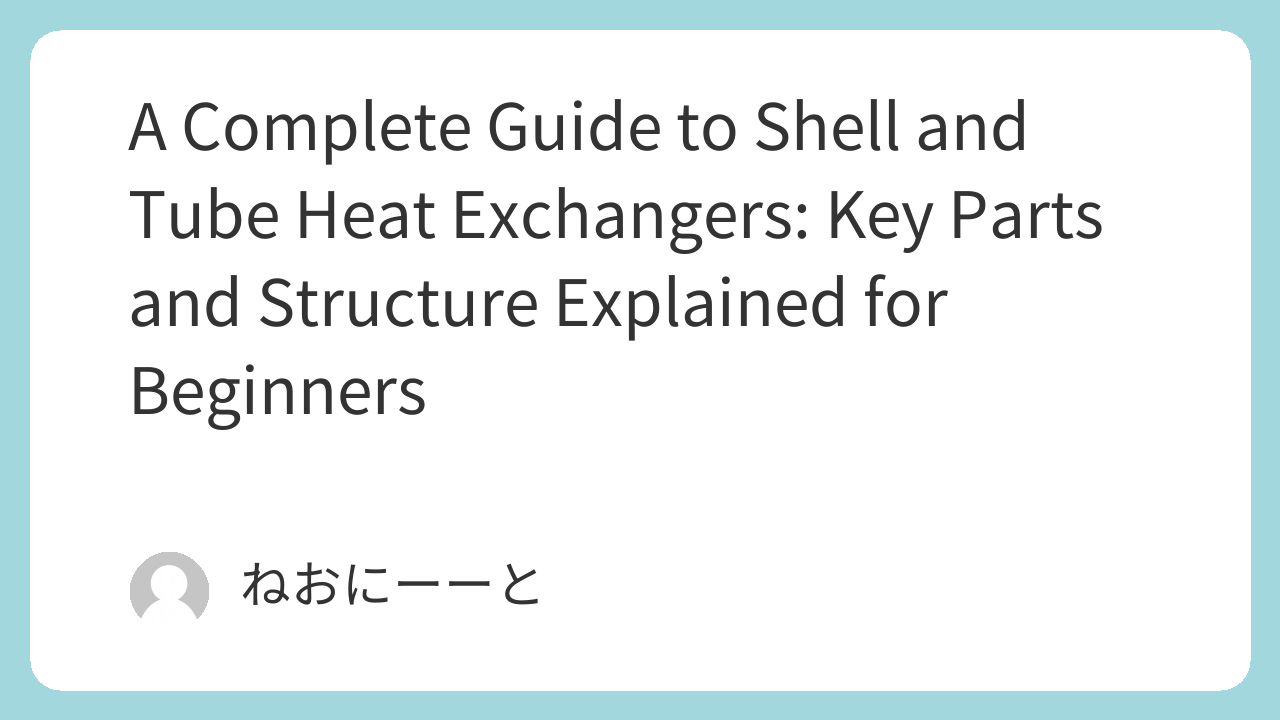Shell and tube heat exchangers are the workhorses of chemical and industrial plants.
For engineers, understanding their internal structure is essential for design, operation, and maintenance.
This article explains each major component — tube, tube sheet, shell, bonnet, baffle, and tie rod — and how they work together to transfer heat efficiently.
Even beginners who find P&IDs or fabrication drawings intimidating can first grasp the structure here, then move to detailed design.
Is the Shell-and-Tube Heat Exchanger the Best Choice for Batch Plants? A Practical Selection Guide
Shell-and-Tube Heat Exchangers Made Simple: A Beginner’s Design Guide for Chemical Plants
1. Overview of the Structure
A shell and tube heat exchanger consists of:
- Tubes — the main heat-transfer path.
- Tube Sheets — fix and seal both ends of the tubes.
- Shell — the outer vessel that holds the secondary fluid.
- Bonnet (Channel Head) — distributes process fluid to and from the tubes.
- Baffles — direct the shell-side flow to enhance heat transfer.
- Tie Rods & Spacers — hold the baffles in position.
- Flanges & Gaskets — ensure leak-tight connections.
The exchanger is typically divided into two zones:
- Bonnet side: where the process or hot fluid enters the tubes.
- Shell side: where the cooling or heating medium flows around the tubes.
Depending on whether the process fluid or the utility (steam, water, oil) is cleaner or more corrosive, you can swap their positions.
2. Tubes and Tube Sheets
The tubes are the heart of the exchanger — numerous small-diameter pipes arranged in a fixed pattern.
Heat transfer occurs across the tube wall by conduction through the metal and convection of both fluids.
- Smaller diameters increase surface area per volume.
- Thinner walls improve heat transfer but must maintain strength.
- Tube materials vary: carbon steel, stainless, titanium, or glass-lined.
The tube sheets fix both tube ends and provide a pressure boundary between shell and tube sides.
Each tube is either welded or expanded (rolled) into the sheet to prevent crevice corrosion and ensure tight sealing.
This joint requires high precision — often done with automatic welding machines.
3. Bonnet (Channel Head)
The bonnet or channel head collects and distributes the process fluid through the tubes.
It connects to the tube sheet with a flanged joint, sealed by a gasket.
Design notes:
- Typically dome- or dish-shaped for strength.
- Can include bottom nozzles to prevent liquid accumulation (“dead zones”).
- Large flange sizes require careful gasket positioning — grooves on the flange face can help maintain alignment.
- Pressure rating doesn’t have to match piping standards (like JIS 10K) exactly — thickness and strength are what matter.
4. Shell Section
The shell encloses the tube bundle and allows the secondary fluid (coolant or heating medium) to pass around the tubes.
The simplest version is a fixed-tube design, where the tube sheet is welded to the shell.
While robust, it limits cleaning access — use clean fluids on the shell side when possible.
In condensers, for example:
- Process fluid often goes through the tubes.
- Cooling water flows through the shell.
However, corrosive or high-purity requirements can reverse this arrangement.
5. Baffles, Tie Rods, and Spacers
Inside the shell, baffles direct the fluid flow across the tubes, improving turbulence and heat transfer.
They are thin plates with cutouts to let fluid pass — cut patterns can be vertical or horizontal.
Design variables include baffle spacing and cut ratio, both crucial for performance and vibration control.
Baffles are supported by tie rods and spacers:
- Tie rods run along the bundle length.
- Spacers maintain the designed gap between baffles.
- One end of the tie rod connects to the tube sheet; the other fixes the baffle stack with nuts.
This simple mechanical structure keeps the entire tube bundle rigid and aligned.
Conclusion
Understanding the parts of a shell and tube heat exchanger — tubes, shell, tube sheet, bonnet, baffles, and supports — is essential for any engineer working with heat transfer equipment.
Each part contributes to thermal efficiency, structural strength, and maintainability.
Once you visualize these components, you’ll find it easier to interpret drawings, troubleshoot performance issues, and communicate with designers or fabricators.

Comments